A requirement within the CAS program is to conduct and complete a CAS project. Students are tasked with planning a ‘collaborative, well-considered series of sequential CAS experiences, engaging students in one or more of the CAS strands of creativity, activity, and service.’
For my CAS project, I was given the opportunity to help Mr. Scott Cairney in coaching middle school (MS) basketball every week, after school, on Friday. Outside of this opportunity, I have also coached MS basketball in grades 9 and 10 with additional help from other students. This time around, coaching MS basketball has been very different. With a significant decrease in the amount of students enrolled in the after school activity (30-40 kids in previous years vs 6-11 kids this year), coaching has become increasingly personal. With more one on one time, unplanned, adapted coaching has become more frequent. I am now able to set up a drill/exercise while pulling a few kids out to help them individually while Mr. Scott continues to supervise the drill. Unfortunately we were not able to organize any games for the MS basketball kids but, through the 6 sessions detailed below which have been completed as of now, my completion of and commitment to this CAS project will become evident.
Session 1, 28th January, 2022
The first session was more of an orientation. We had 6 students, so Mr. Scott and I played half-court 4v4 with them to identify areas for growth as well as identify their strengths and their overall skill levels. From this first session I observed that 1 student excelled over the rest as he had been playing basketball for a while and 4 students were familiar with the sport but were still quite new to the sport. There was also 1 student that was a beginner and needed help to assert themself into the game. This session was extremely insightful as it allowed for me to understand the general skill level of the students and adapt my coaching approaches for future sessions to best fit their needs.
There were also some areas for growth amongst all of the students. Firstly, there was a major problem with teamwork as none of the students understood the importance of passing. They were all focused on showcasing their own individual skill, which actually resulted in underperformance as they attempted to do things that were way more advanced than their skill level. Noticing this area for growth will aid me in coaching them in the future as I plan to teach them the 5-out offense to help them improve their teamwork. Additionally, there was a major problem with defensive motivation which could be related to a lack of defensive awareness. The players that seemed to be more familiar with the sport seemed as if they were not interested in playing defense but the rest of the players seemed as though they weren’t sure about what to do or where to be on defense. This means that I will have to teach them the shell defense to help them understand where they should be on defense and what they should be doing. Lastly, related again to my point about their focus on showcasing their skills, there was a problem with shot selection as many of the shots taken were forced. I will have to teach them how to evaluate when a shot is worth taking and when there is an opportunity for a better shot to be taken.
Session 2, 11th February, 2022
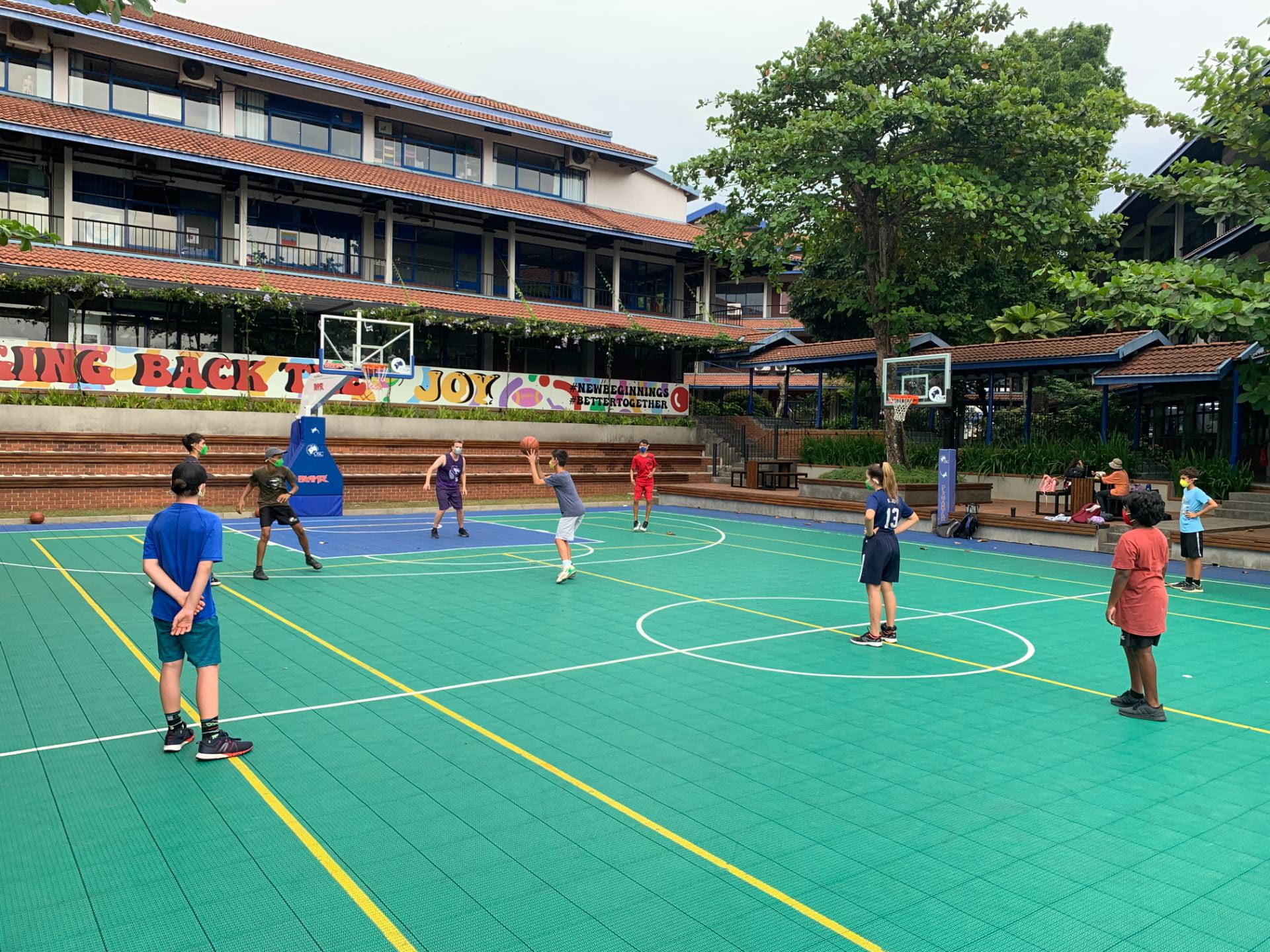
Instead of teaching them the 5-out offense on the second session, I felt as though it was important to run them through a more simplified offensive drill that still trains their passing abilities and overall teamwork. This drill, as can be seen in Figure 1, gives the offense an advantage as they have 1 more player than the defense. Due to me being injured, I could not engage in the drill so Mr. Scott had to fill in for me on defense. This drill was meant to teach them how to pass to get around the defense as there was 3 offensive players and 2 defensive players. After each student had the opportunity to play both defense and offense a couple times, the drill was further simplified to a 2 on 1. This adaptation still trained their teamwork and passing abilities but unalike the 3 on 2, it was faster paced which is more like a real game.
This time we had 9 players instead of 6 players which allowed for a full court 5 on 5 to end the session. As stated before, I was injured so I couldn’t engage so Mr. Scott, who has basketball experience, filled in the last spot. I implemented a rule which called for each offensive player to have touched the ball before someone is allowed to shoot and ultimately score. This rule worked in conjunction with the drill executed earlier in the session as it continued to train their teamwork and passing abilities. In addition to this rule I implemented, I also stopped the game frequently in order to explain areas for improvement, making this scrimmage a guided scrimmage.
Session 3, 18th February, 2022

For the third session I decided to focus on their defense which proved to be a persisting area for growth in sessions 1 and 2. I decided to teach them the most important and recognized man-to-man defensive strategy, the shell defense. For more information on how the shell defense works, click on this link. For the most part, as seen in Figure 3, they understood the concept but I was still skeptical of how they would perform it during the scrimmage.
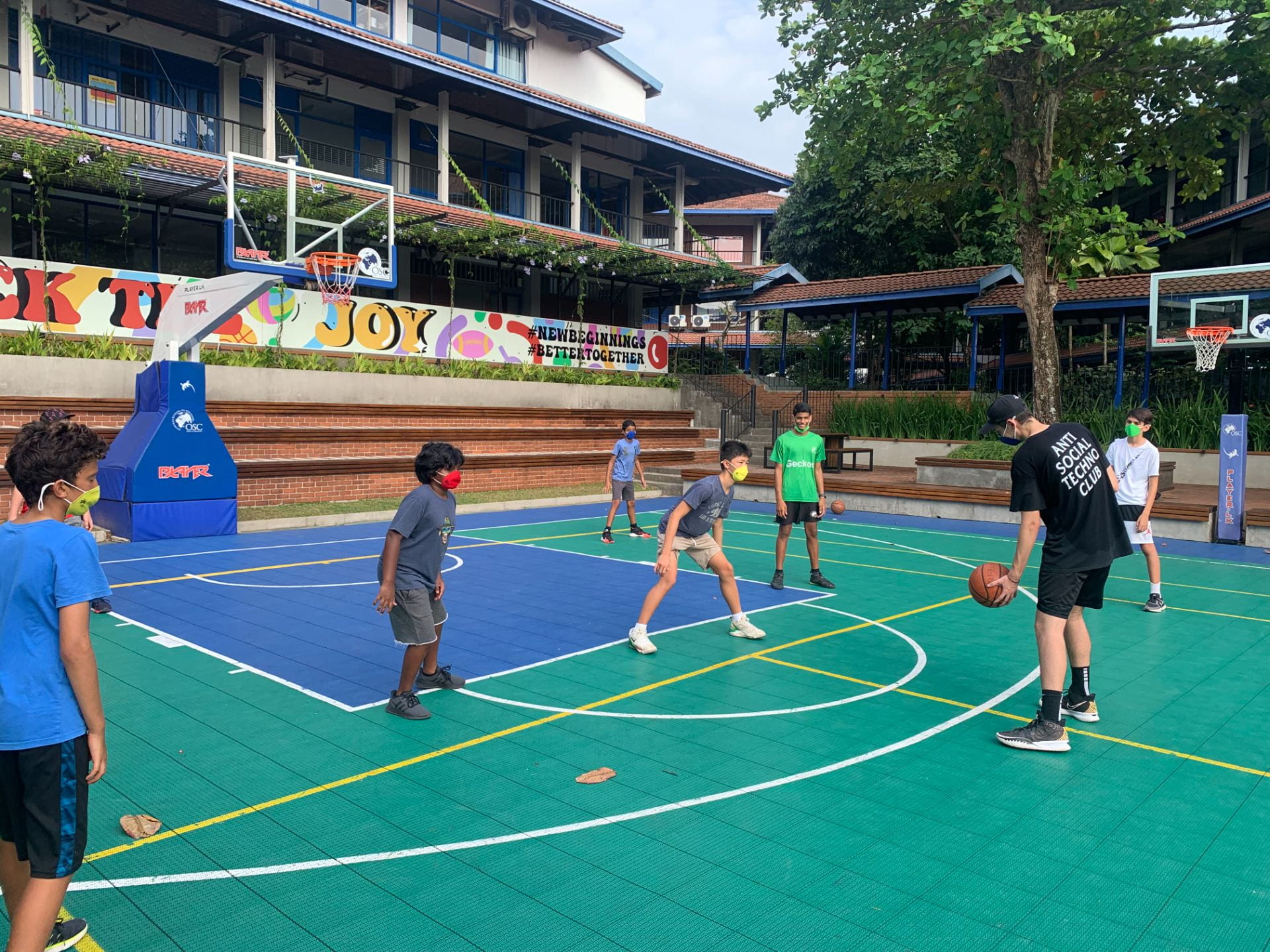
After teaching them and having each person execute the defense properly, I decided to join them in a guided full court 5 on 5 scrimmage for the last 15 minutes of the session. As done in session 2, I stopped the game frequently to explain areas for growth. 2 players out of the 9 that came to the session were performing the shell defense perfectly. 5 of them were meeting expectations regarding the execution of the shell defense but 2 of them could not understand it whatsoever. All in all, teaching them this defense really helped the players to understand the importance of good defense and how to execute it properly.
Session 4, 25th February, 2022
Unfortunately, today was a rainy day so it was impossible to play as the court becomes extremely slippery when wet. Only 4 students showed up for this session so I decided to let them shoot around without any sprinting so that they don’t get injured. While they were shooting around, I came around to each of them and gave them personal advice on how they could improve their jump shot – or shooting technique.
Session 5, 4th March, 2022
Now that the students were more familiar with how to execute the shell defense, I felt as though it was important to train their individual offensive abilities so I decided to help them work on their abilities to make both right handed and left handed layups. The layup, with exception to the free throw, is the easiest shot in basketball but it also one of the most useful shots. Although it seems simple, it is imperative that correct technique is used when executing the layup at the beginner level. Of course, as a player progresses and becomes more advanced, there are multiple adaptations to the layup but for this MS basketball session, I decided to focus on the generic left and right handed layup. Because there were varying skill levels amongst the students, I did individual training with the less-experienced players and helped them to perfect their execution of the layup, After this, I decided to a play in a guided 4 on 4 game with frequent stoppages to explain mistakes and help them improve.
Session 6, 11th March, 2022
Today’s session was focused on giving the kids a basis for a good and commonly used offensive system – the 5-out offense. Its sole purpose is to engage the offense by forcing them to pass the ball, and then relocate to a different position, subsequently exposing gaps in the defense with the aim of scoring an easy, wide open basket. Figure 4 details the basic movements for this offense and this link explains it more thoroughly.
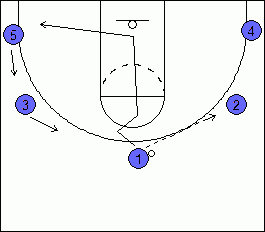
As can be seen in Figures 5 and 6 below, I engaged in the offense when practicing in order to help facilitate the movement and provide on-court instructions for the students. Even though the concept is simple – you pass the ball, cut the rim while the teammates on the opposite side of the pass fill in your empty space and you go to the opposite corner – the students had difficulties implementing this when playing at a game speed. This offense has been engrained in my brain since I was playing basketball in Bangkok at 11 years old and has proven to be one of, if not the most, effective basic offensive strategies.
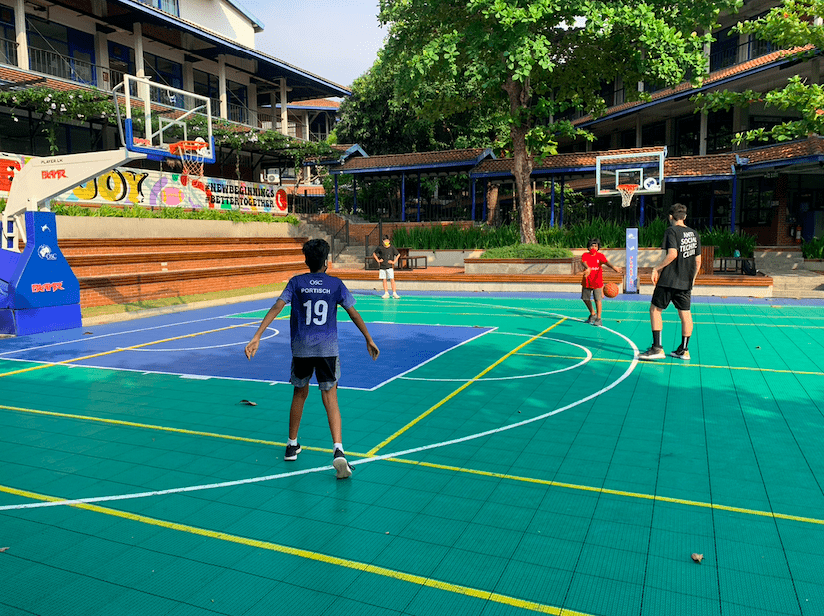
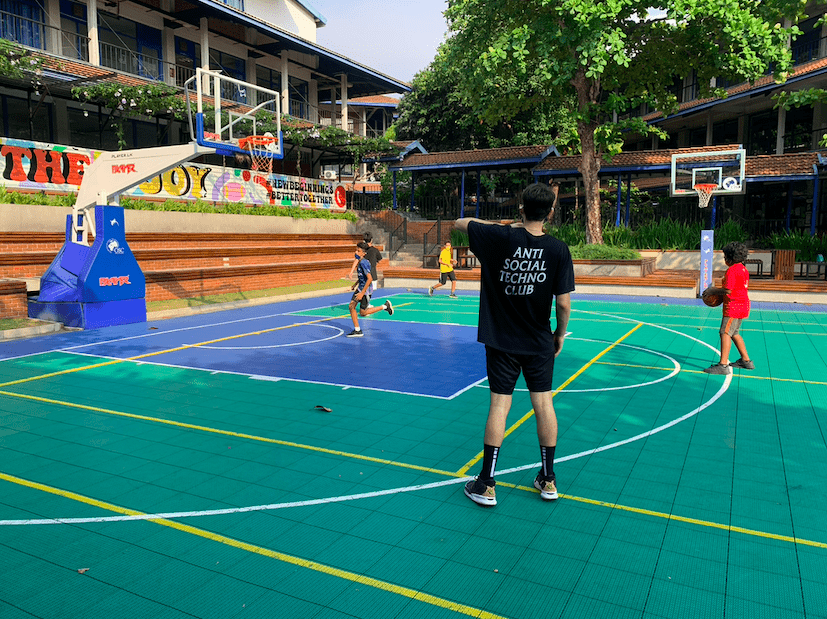
Learning Objectives
Identify own strengths and develop areas for growth
I feel as though through this coaching experience I was able to identify my own strengths and also develop areas for growth. I identified my own strengths by transferring the knowledge obtained from training with Praneeth Udumalagala (Sri Lankan national player) into training the middle school kids. The offensive and defensive strategies were strategies that I had understood prior to training with Praneeth but I never understood the reason why it existed and how to explain it to others. Furthermore, from researching the game of basketball extensively and being trained by former NBA players throughout my lifetime, I have gained valuable and teachable knowledge on the fundamentals of basketball. I am now able to explain, in depth, the exact ‘perfect’ mechanics of a basic layup and shooting form as well as passing techniques and the defensive stance/slide.
I feel as though an area for growth which I developed was my ability to keep the students engaged and focused throughout the session. When I coached MS basketball in 9th and 10th grade I had the help of Mr. Rossberg who has a very large presence and could easily get the students focused through intimidation of a physical punishment. Now, Mr. Scott has decided to give me the liberty of running the sessions and keeping the students focused and engaged. While I have learned multiple techniques to do so, there are still clear areas for improvement as my techniques seemed to only last 20 minutes at a time before a physical punishment would have to be implemented.
Demonstrate that challenges have been undertaken, developing new skills in the process
The main challenge I faced throughout this project was that we had to play on the outdoor court which made rainy days impossible. Furthermore, it increased the overall fatigue of the students as we were constantly under the hot, glaring sun. Subsequently, this caused a decrease in attention span and engagement. As explained earlier, throughout the process, I learned and implemented different techniques to keep the students engaged. Additionally, there were significantly less students than expected – which wasn’t all bad. At first I was a little skeptical as to how the sessions would go considering I had only coached larger amounts of students. This made the training sessions more personal and forced me to really highlight individual areas for growth amongst the students. This decrease in students made me act more like a trainer than a coach – which is something I had never experienced as I was usually on the receiving end of training.
Demonstrate how to initiate and plan a CAS experience
I demonstrated how to initiate and plan a CAS experience as, before each session, I came up with plans that detailed the structure of the upcoming session. Furthermore, I frequently discussed potential drills and areas for improvement amongst the students with Mr. Scott at break times and lunch times or even passing through the halls, proving that I was dedicated to carrying out a planned CAS experience. Additionally, by logging and keeping track of each session, I have shown that I approached this CAS project in an organized manner.
Show commitment to and perseverance in CAS experiences
Lastly, I showed commitment to and perseverance in this CAS project as I consistently showed up to each session. Many of these Fridays I either had plans with friends that had to be postponed or I had big assignments that I needed to work on. Regardless, through injury and adversity, I decided to come to each session with a plan. Additionally, I still coached on the rainy day instead of calling off practice which shows how committed I was to helping these students progress in the sport of basketball. This also proves my perseverance in the CAS project as I faced adversity with the slippery court but still decided to show up and make an effort to train the students.
Conclusion
In conclusion, this CAS project was a success. While facing adversity and challenges numerous times, I was still able to teach the students valuable drills from every aspect of the sport. This knowledge obtained through the experience will benefit me tremendously in my future endeavors as it has taught me the skills and importance of leadership. Furthermore, if I decide to continue coaching/training basketball, I will have a strong foundation which will allow for me to properly execute sessions.
Supervisor
Mr. Scott Cairney
Works Cited
“5 Out Motion Offense – Cutters.” BREAKTHROUGH BASKETBALL, https://www.breakthroughbasketball.com/offense/cutters.html.
“Shell Drill – Basketball Defense Drill.” Hoop Student, 1 Nov. 2020, https://hoopstudent.com/shell-drill/.